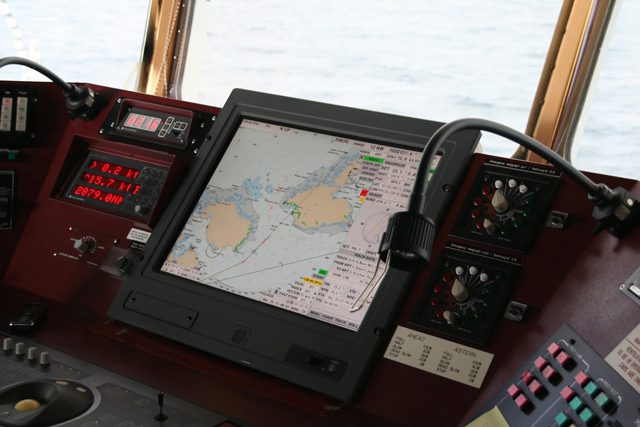Was The World’s ‘Northern-Most Island’ Erased From Charts?
by Kevin Hamilton (University of Hawaii) In 2021, an expedition off the icy northern Greenland coast spotted what appeared to be a previously uncharted island. It was small and gravelly,...


Recognition and Early Intervention Avoid Previously Undiagnosed Deck Officer Health Issues
By Capt. I.M. Anonymous
Trackline Attachment Syndrome (TAS) is the tendency of navigators, commonly younger mates, but often noted during observation of even seasoned captains, to develop an unhealthy and obsessive need to place and keep a pictorial representation of their vessel upon an arbitrary pixelated line or series of lines presented on a computer monitor, usually positioned directly in their line of vision; often (especially during periods of darkness) obscuring other important aids to navigation such as “wisdom,” “windows” and “RADAR.”
Over long periods of time this syndrome becomes exacerbated by a sometimes complete loss of peripheral awareness known as Cross Track Error Phobia (C-TEP). Left untreated, the combination of the two lead, in 98.5% of cases, to Trackline Separation Anxiety Disorder (TSAD).
TSAD is an emerging disorder, exacerbated by the Manila Agreements, first noted by qualified professional assessors during repeated sessions of simulator navigation assessment of mariners.
Further real-world research has indicated that TSAD is a potentially temporary yet oftentimes permanent disorder brought on by undiagnosed, untreated or improperly treated cases of TAS and TSAD. It has been noted that early intervention prior to the onset of C-TEP is most successful and has a cure rate of nearly 90%. Once the affected navigator develops full-blown TSAD, even with proper intervention the cure rate at present is an abysmal 0.33%.
Early diagnosis is important
Diagnosis of early-onset TAS and C-TEP is simple (by qualified navigators) and misdiagnosis is nearly impossible. Simply place the ECS/ECDIS display power switch in the “OFF” position suddenly and without warning and observe the reaction of the navigator. A yawn or a delayed (more than 30 seconds) recognition of the darkened display indicates asymptomatic response and no presence of the syndrome and no further treatment is required.
Exhibition of immediate stress and panic factors indicates, at the minimum, the presence of TAS and further follow-up in controlled conditions is recommended. Loss of consciousness in extremely advances cases warrants immediate removal of the navigator from the watch rotation and flyers and pamphlets touting the engine department career track should be administered to the patient.
TSAD diagnosis is frequently accomplished at a distance by other vessels in the operating area by monitoring VHF radio. The most common and absolutely unmistakable indicator is the insistence, often in a panic-strike tone, by one vessel (usually the give-way vessel) to another vessel “YOU”RE ON MY TRACKLINE!!”
This I have personally been told in radio traffic originating from Training Ships in both the Pacific Ocean and the Caribbean Sea, and my diagnosis of TSAD in both cases was immediate and unarguable. I am confident that the disorder was immediately diagnosed and treatment is ongoing aboard each ship by the licensed officer(s) monitoring the cadet(s).
Proper treatment show promise
There have been many suggestions as to the best treatment methodology. As of yet there is no universal agreement and creative approaches to treatment are emerging in the literature. As an early advocate of proactive intervention, I have used the following strategies:
Placing the ECS or ECDIS display in a position behind the navigator had early success however surreptitious monitoring indicates that most navigators quickly adjust their position on the bridge by rotating their bodies 180 degrees to compensate, rendering this strategy ineffective.
Placing the power switch in the “OFF” position (the so-called “Cold Turkey” solution) is immediately effective however it must be noted that legal issues complicate this approach to treatment and as such it should only be attempted by Masters who carry license insurance and/or choose to remain on the bridge at all times.
Allowing my navigating officers an unlimited cross-track error factor on the ECS/ECDIS systems while assessing, planning, executing, and monitoring appropriate and prudent cross-track error limits on “paper charts” which, depending on the company, are sometimes available in the pilothouse.
Of the three, the last has been the most successful.
My hope is that this short article will raise awareness and help prevent the steady progression from syndrome to phobia to disorder.
Join the gCaptain Club for curated content, insider opinions, and vibrant community discussions.


Join the 105,926 members that receive our newsletter.
Have a news tip? Let us know.
Access exclusive insights, engage in vibrant discussions, and gain perspectives from our CEO.
Sign Up




Maritime and offshore news trusted by our 105,926 members delivered daily straight to your inbox.



Essential news coupled with the finest maritime content sourced from across the globe.
Sign Up